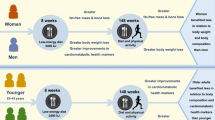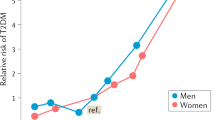Abstract
We compared cardiovascular risk factors in younger and older patients with Type 2 diabetes mellitus and higher than normal body mass index (BMI) and percentage of body fat (% BF) after a 1-yr weight-reduction program in order to clarify the benefits of weight loss in the overweight elderly. Groups of 52 younger and 50 older patients consumed low-calorie diets and participated in a simple moderate-intensity aerobic exercise program for 1 yr. At three times during the program (start, 6 months, 12 months), 10 measures were taken for each participant: BMI, total cholesterol (TC), triglyceride (TG), % B F, waist circumference (WC), fasting plasma glucose, hemoglobulin A1c (HbA1c), leptin, high-sensitivity C-re-active protein (hs-CRP), and adiponectin levels. While changes in BMI, TC and TG were evidently the same in both age groups (p-value: 0.11, 0.33, 0.70, respectively), raw figures for change in % BF, WC, fasting plasma glucose, HbA1c, leptin, hs-CRP, and adiponectin values were significantly greater in the older group (p-value: 0.02, 0.01, 0.03, 0.04, 0.02, 0.01, 0.03 respectively). However, after adjusting for % BF and WC, these changes were no longer significant (p-values: 0.08, 0.07, 0.08, 0.06, 0.10, respectively), indicating that weight loss is equally beneficial for overweight patients with Type 2 diabetes in both age groups. Benefits were gained mainly through reduced body fat. Simple life-style modification of adding 20-min daily aerobic exercise and an adequate but restricted calorie diet is more effective in elderly diabetic patients.
Similar content being viewed by others
References
Erents B, Primatesta P. Health survey for England. Cardiovascular disease ′98. London: The Stationary Office London. 1999.
Waaler HT. Hazard of obesity — the Norwegian experience. Acta Med Scand Suppl 1988, 723: 17–21.
Elia M. Obesity in the elderly. Obes Res 2001, 9(Suppl 4): 244–8.
Rössner S. Obesity in the elderly — A future matter of concern? Obes Rev 2001, 2: 183–8.
Fletcher GF, Balady G, Blair SN, et al. Statement on exercise: benefits and recommendations for physical activity programs for all Americans. A statement for health professionals by the Committee on Exercise and Cardiac Rehabilitation of the Council on Clinical Cardiology, American Heart Association. Circulation 1996, 94: 857–62.
Grundy SM, Blackburn G, Higgins M, Lauer R, Perri MG, Ryan D. Roundtable consensus statement: Physical activity in the prevention and treatment of obesity and its comorbidities. Med Sci Sports Exerc 1999, 31: S502–8.
Dalton M, Cameron AJ, Zimmet PZ, et al. Waist circumference, waist-hip ratio and body mass index and their correlation with cardiovascular disease risk factors in Australian adults. J Intern Med 2003, 254: 555–63.
Jia WP, Lu JX, Xiang KS, Bao YQ, Lu HJ, Chen L. Prediction of abdominal visceral obesity from body mass index, waist circumference and waist-hip ratio in Chinese adults: receiver operating characteristic curves analysis. Biomed Environ Sci 2003, 16: 206–11.
Clement K, Vaisse C, Lahlou N, et al. A mutation in the human leptin receptor gene causes obesity and pituitary dysfunction. Nature 1998, 392: 398–401.
Halaas JL, Gajiwala KS, Maffei M, et al. Weight-reducing effects of the plasma proteins encoded by the obese gene, Science 1995, 269: 543–6.
Fischer S, Hanefeld M, Haffner SM, et al. Insulin-resistant patients with type 2 diabetes mellitus have higher serum leptin levels independently of body fat mass. Acta Diabetol 2002, 39: 105–10.
Hu E, Liang P, Spiegelman BM. AdipoQ is a novel adipocytes-specific gene dysregulated in obesity. J Biol Chem 1996, 71: 10697–703.
Ouchi N, Kihara S, Artia Y, et al. Novel modulator for endothelial adhesion molecules: adipocytes-derived plasma protein adiponectin. Circulation 1999, 100: 2473–6.
Weyer C, Funahashi T, Tanaka S, et al. Hypoadiponectinemia in obesity and type 2 diabetes; close association with insulin resistance and hyperinsulinemia. J Clin Endocrinol Metab 2001, 86: 1930–5.
Berg AH, Combs TP, Scherer PE. ACRP30/adiponectin: an adipokine regulating glucose and lipid metsbolism. Trends Endocrinol Metab 2002, 13: 84–9.
Yamamoto Y, Hirose H, Saito I, et al. Correlation of the adipocyte-derived protein adiponectin with insulin resistance index and serum high-density lipoprotein-cholesterol independent of body mass index, in the Japanese population. Clin Sci 2002, 13: 137–42.
Hotta K, Funahashi T, Arita Y, et al. Plasma concentrations of a novel, adipose-specific protein, adiponectin, in type 2 diabetic patients. Arterioscler Thromb Vasc Biol 2000, 20: 1595–9.
Rifai N, Ridker PM. High-sensitivity C-reactive protein: A novel and promising marker of coronary heart disease. Clin Chem 2001, 47: 430–11.
Depress JP, Moorjani S, Lupien PJ, Tremblay A, Nadeau A, Bouchard C. Regional distribution of body fat, plasma lipoproteins, and cardiovascular disease. Atherosclerosis 1990, 10: 497–511.
Tracy RP. Is visceral adiposity the “enemy within”? Arterioscler Thromb Vasc Biol 2001, 21: 881–3.
Lemieux I, Pascot A, Prudhomme D, et al. Elevated C-reactive protein: another component of the atherothrombotic profile of abdominal obesity. Arterioscler Thromb Vasc Biol 2001, 21: 961–7.
Hak AE, Stehouwer CD, Bots ML, et al. Associations of C-reactive protein with measures of obesity, insulin resistance, and subclinical atherosclerosis in healthy, middle-aged women. Arterioscler Thromb Vasc Biol 1999, 19: 1986–91.
Chan DC, Watts GF, Barrett PH, Bellin IJ, Mori TA. Effect of atrovastatin and fish oil on plasma high-sensitivity C-reactive protein concentrations in individuals with visceral obesity. Clin Chem 2002, 48: 877–83.
Pearson TA, Mensah GA, Alexander RW, et al. Markers of inflammation and cardiovascular disease: application to clinical and public health practice: A statement for healthcare professionals from the centers for disease control and prevention and the American Heart Association. Circulation 2003, 107: 499–511.
Tchernof A, Nolan A, Sites CK, Ades PA, Poehlman ET. Weight loss reduces C-reactive protein levels in obese postmenopausal women. Circulation 2002, 105: 564–9.
McLaughlin T, Abbasi F, Lamendola C, et al. Differentiation between obesity and insulin resistance in the association with C-reactive protein. Circulation 2002, 106: 2908–12.
Knowler WC, Barrett-Connor E, Fowler SE, et al. Diabetes Prevention Research Group. Reduction in the evidence of type 2 diabetes with lifestyle intervention or metformin. N Engl J Med 2002, 346: 393–403.
Tuomilehto L, Lindstrom J, Eriksson LG, et al. Prevention of type 2 diabetes mellitus by changes in lifestyle among subjects with impaired glucose tolerance. N Engl J Med 2001, 344: 1343–50.
Pan XR, Li GW, Hu YH, et al. Effect of diet and exercise in preventing NIDDM in people with impaired glucose tolerance: the Da Qing IGT and Diabetes Study. Diabetes Care 1997, 20: 537–44.
Author information
Authors and Affiliations
Corresponding author
Rights and permissions
About this article
Cite this article
Hsieh, C.J., Wang, P.W. Effectiveness of weight loss in the elderly with Type 2 diabetes mellitus. J Endocrinol Invest 28, 973–977 (2005). https://doi.org/10.1007/BF03345334
Accepted:
Published:
Issue Date:
DOI: https://doi.org/10.1007/BF03345334




